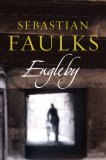Stephen Hayes's Blog, page 47
May 30, 2015
Morning Prayer of the Last Elders of Optina
Many Orthodox Christians end their morning prayers with the following “Morning Prayer of the Last Elders of Optina”.
O Lord, grant that I may meet all that this coming day brings to me with spiritual tranquillity. Grant that I may fully surrender myself to Thy holy will.
At every hour of this day, direct and support me in all things. Whatsoever news may reach me in the course of the day, teach me to accept it with a calm soul and the firm conviction that all is subject to Thy holy will.
Grant that I may deal straightforwardly and wisely with every member of my family, neither embarrassing nor saddening anyone.
O Lord, grant me the strength to endure the fatigue of the coming day and all the events that take place during it. Direct my will and teach me to pray, to believe, to hope, to be patient, to forgive and to love.
Amen.
Optina Monastery (Оптина пустынь — Optina Pustyn) was a monastery in Russia famed for its spiritual elders (Russian: startsi). It was closed by the Bolsheviks, and the monks were scattered. Some were imprisoned, and some were killed. The “news that reached them in the course of the day” was often that some of their brethren had been arrested, tortured, or killed. The monastery has now been reopened and rebuilt. 


May 20, 2015
The Benedict Option?
I heard about the Benedict Option for the first time today, and it’s only 7:15 am, which means I heard about it very recently indeed. So why am I writing about it when I hardly know what it is?
I suppose I’m writing about it because it gives me a strong sense of Déjà vu, the feeling that I’ve been here before.
A friend, Irving Hexham, posted a link on Facebook with this comment, “This article is a critique of the latest American evangelical fad, or should I say madness”: Serious, Non-Sarcastic Questions About the Benedict Option | The American Conservative:
I have great respect and affection for my colleague, Rod Dreher. But I have to admit, I am very frustrated by his latest obsession, because I don’t understand what it means.
I’m talking about the so-called “Benedict Option.” I know where the phrase comes from. It’s a reference to Alasdair MacIntyre’s book, After Virtue, which I read with interest several years ago. I don’t remember the book well enough to give a fully accurate summary, but the heart of it was a critique of the modern condition from an Aristotelian (filtered a bit through Hegelian historicism) perspective.
I’d never heard of MacIntyre or his book, but it seemed to me that this was very similar to what the hippie comune movement was about in the 1960s, and the Catholic Worker movement long before that. And in the 1960s some of us had dreams of establishing communities (that are today called by some Evangelicals “neomonastic”) in which we would teach theology, politics and agriculture. We spoke of such things as “Christian kibbutzim” because “commune” had not yet become part of everyday speech. Much of it was inspired by Dietrich Bonhoeffer’s book “Life together”. Some of what MacIntyre was said to be saying about modernity also seemed to strike a chord with me.
Noah Millman, in his article Serious, Non-Sarcastic Questions About the Benedict Option, goes on to say:
…most of what I’ve seen is discussion of how corrupt and threatening to Christianity the surrounding culture is becoming, and how small-o orthodox Christians need to recognize that fact and prepare for it, combined with repeated assurance that the Benedict Option does not mean withdrawing from the world or compromising the Christian obligation to witness, spread the gospel, be in the world while not of it, etc.
And in that there are echoes of the 1970s and 1980s in South Africa, when Christians who refused to burn incense on the altar of the ideology of apartheid and were not totally subservient to the Nationalist government were regarded as part of the Total Onslaught and many of us thought that we needed to prepare for more and more persecution as the Total Strategy was refined and applied.
So we were, and were probably regarded by our contemporaries, as the “Religious Left”. I was therefore somewhat surprised to discover that this new movement, in spite of its apparent similarities, was regarded as a movement of the “Religious Right” in the USA: The Benedict Option: Why the religious right is considering an all-out withdrawal from politics:
Have you heard of the Benedict Option? If not, you will soon.
It’s the name of a deeply pessimistic cultural project that’s capturing the imaginations of social conservatives as they come to terms with the realization that the hopes and assumptions that animated the religious right over the past 35-odd years have been dashed by the sweeping triumph of the movement for same-sex marriage.

St Benedict of Nursia
The problem is that all this seems to point back to Rod Dreher, who is not, as far as I know, an Evangelical (in the American sense), but an Orthodox Christian. I had not paid much attention to the writings of Rod Dreher, though I’ve followed a number of Orthodox bloggers, some of whom referred to him. I suppose that was mostly prejudice on my part, as he described himself in his blog as “Crunchy Con”, an epithet that was quite opaque to me. It made me think of celery and people who make their living from scams. No doubt there was an in-group who knew the connotations of the term “Crunchy Con” and I got the impression that he was speaking primarily to that in-group, people who who knew what “crunchy con” meant and didn’t need to ask. Rightly or wrongly, I thought that if one needed to ask, one wouldn’t be welcome. There are quite a number of bloggers, and others, who use this kind of language, suggesting a shared set of assumptions. If you don’t share the assumptions and don’t grasp the allusions and have to ask what they mean, then you are ipso facto a member of the out-group.
Now that all may be a bunch of presumptuous assumptions on my part, and perhaps I should have been paying more attention to what Rod Dreher is saying, especially if we are going to be hearing a lot more about the Benedict Option in future.
So it will be very interesting to see how American Evangelicals of the Religious Right are led by an Orthodox Christian into a life of hippie communes. The mind, as they say, boggles.


Can we only understand racism in terms of postmodern litcrit academic jargon?
There seems to be a growing tendency among academics to define racism in terms so abstract and obscure that it is difficult to know what they are talking about. The most recent example I have enountered takes the cake: You must be in deep denial Max du Preez – Sunday Independent:
There is a new non-racist discourse that contains implicit racism though its purveyors seem not to recognise it. This is a depoliticised liberal discourse that has enabled some to convince themselves they are not racist whilst they spew racist discourse on social platforms and into their columns at an alarming rate.
So cleverly disguised is it in a seemingly benign veneer that there is often not even an outcry from the public. The modus operandi of this contemporary discursive trend appears to be to downplay the race element in the master narrative and hoodwink all into believing that racism is no longer a problem.
Rather, it is now about race denialism and it is very clear how the discourses of power, social discourses and media discourses seek to mollify, circumvent, disguise and even ignore the issue of racism in contemporary societal narratives.
This is the trick of the new depoliticised liberal double-speak. It allows racists to be racist without any accountability.
Four paragraphs into the article and I still don’t have a clue about what Max du Preez is supposed to be denying. All it is is a lot of very abstract nebulous jargon, which is as easy to grasp as morning mist.
And that’s the point where I stopped reading. I don’t know what Max du Preez said, and I don’t particularly care what he is alleged to be or what he is actually denying or actually affirming. What I do care about is this kind of diseased language that seems to be a mammoth con trick to persuade readers that since they cannot understand it without an English Honours Degree in the right school of literary criticism it must therefore be profound and important, and leave it to the academics who are fluent in this kind of cant to define what racism means for the rest of us.
One of the better comments on this kind of language was made by Stanislav Andreski, himself an academic, aimed at colleagues in his own discipline, Social Science.
The attraction of jargon and obfuscating convolutions can be fully explained by the normal striving of humans for emoluments and prestige at the least cost to themselves, the cost in question consisting of the mental effort and danger of ‘sticking one’s neck out’ or ‘putting one’s foot in it’. In addition to eliminating such risks, as well as the need to learn much, nebulous verbosity opens a road to the most prestigious academic posts to people of small intelligence whose limitations would stand naked if they had to state what they have to say clearly and succinctly (Andreski, Social sciences as sorcery, p 82).
If we can only talk about racism in such complicated and abstract terms, it disempowers most of the people who have historically been victims of racism in South Africa, since for most of them English is a second or third language.
 Even as a native English speaker, I find it almost impossible to understand phrases like “modus operandi of this contemporary discursive trend”, so how easy must it be for those for whom English is a second or third language? In my understanding of English, “discursive” discourse means discourse that is rambling and digressive, wandering around all over the place without ever really coming to the point. I have a vague idea that in postmodern literary criticism it has some kind of specialist meaning, but I’m not sure what it is. But I do think that if people want to use such language, they should be writing in academic journals rather than Sunday newspapers.
Even as a native English speaker, I find it almost impossible to understand phrases like “modus operandi of this contemporary discursive trend”, so how easy must it be for those for whom English is a second or third language? In my understanding of English, “discursive” discourse means discourse that is rambling and digressive, wandering around all over the place without ever really coming to the point. I have a vague idea that in postmodern literary criticism it has some kind of specialist meaning, but I’m not sure what it is. But I do think that if people want to use such language, they should be writing in academic journals rather than Sunday newspapers.
If we can’t talk about racism without using such elitist academic language, then we can’t talk about racism at all.
Though apartheid, the insitutionalised legalised form of racism, ended 21 years ago, racism has not gone away, and can be seen all around us, so we do need to talk about it. And we all need to talk about it; the discussiojn should not be confined only to those who can follow the convoluted abstractions that some academics are so fond of.
Here are some useful links:
Jargon, convoluted obfuscation profundicates honcho
Jargon and obfuscation in academia
Jargon in Writing
For an example of writing about racism that is clear and easy to understand, try this article White Racism Matters! | CounterPunch:
…the wave of recent anti-police brutality protests has provoked a backlash in certain quarters, revealing the oozing sludge of bigotry that in more quiescent times simmers just beneath the surface of some segments of “civilized” white society.
Social media is one barometer of this entrenched prejudice. Consider the YouTube video circulating in recent months claiming to show Ferguson, Missouri teenager Michael Brown engaged in an assault on another man. One link to this video (since removed) showed millions of viewers, titled “Michael Brown Criminally Assaults and Robs an Older Man,” and begins by describing what follows as “What Al Sharpton and Jesse Jackson Don’t Want You to See.”
The video shows a stocky young Black man physically assaulting an older man outside an apartment complex. It’s ugly to watch, as the older man can’t do much to defend himself. Too bad the video is from 2012, was filmed in Woodland, Texas, and the real Michael Brown is nowhere to be seen, as the Christian Science Monitor reports. This is only one of many slanders against Michael Brown that has gone viral in social media.
You don’t need a postgrad degree in postmodern litcrit to understand that. OK, it’s not in South Africa and it doesn’t try to give a definition of racism, postmod or otherwise, but it operates on the “you know it when you see it” principle. And social media are everywhere, and don’t tell me no one in South Africa has ever retweeted or shared those things about Michael Brown being guilty, which of course is not just racism, but also prejudice.


May 16, 2015
Engleby by Sebastian Faulks (book review)
My rating: 4 of 5 stars
Four years ago…
I was a bit reluctant to start reading this book, because the last book I read by Sebastian Faulks, Human traces I hadn’t enjoyed very much. So though my wife had bought this one three years ago (in 2008), and it has sat on the shelf since then, I had not read it. But then looking for something I hadn’t read for bed-time reading I picked it up and started it, and it seemed quite different from Human traces and I was rather enjoying it and finding it interesting, and beginning to think it was the best thing I had read by Sebastian Faulks.
So I had reached page 280 and hoped to finish it tonight. But unfortunately page 280 was followed by page 25, and it seems that the book has been misbound. After three years it is probably far too late to take it back to the bookshop and ask for another copy that has been properly bound — they probably won’t even have one in stock anyway. And though one might be able to order another copy from the publishers, it seems a bit of a waste to pay the full price of a book for the last 60 pages or so, and anyway by the time it arrived I’d probably have forgotten most of the story anyway and would have to start again from the beginning. I just wish printers would be more careful in checking their stuff. I see it was printed and bound in Greeat Britain by Clay Ltd, St Ives plc. If by any remote chance anyone from there happens to read this, perhaps they’ll take pity on me and send an intact copy.
Four years later
I found a copy in the library, and so at last was able to finish it, and, as I thought, I had forgotten most of the plot, and so had to start again from the beginning.
And that in itself was remarkable. There were no spoilers, Even after having read three=-quarters of the book only four years ago, the unexpected twists and turns of the plot were still unexpected. And re-reading one of them did not call to mind the memory of the next one or any of the others. I simply could not foresee what was going to happen. It was like reading the book for the first time.
That in itself is interesting, because a lot of the plot turns on time and memory, and the inability to remember certain things. If I can’t remember what happened in the story, it makes the story itself more plausible.
But if I could not remember the plot itself, and the events in the story, there was still a feeling of having been here before, and perhaps appreciating, even more than the first time around, some of the observations of the protagonist on life in the 1970s and 1980s, and even on life in general.
I give one quote of many, take it how youo will:
And it’s true that you can’t bend with each fashionable wind — you can’t be like the Church of England, constantly updating its eternal verities. Either Christ was God, in which case He knew what He was doing when He chose male apostles only; or, he was a hapless Galilean sexist now ripe for a rethink. Not both.


May 14, 2015
UK trip 15 May 2005: Monastery and Essex Girls
Continued from UK trip 14 May 2005: cathedral & monastery | Khanya
I woke up about 4:30 am in the guest room at the Monastery of St John the Baptist at Tolleshunt Knights in Essex, and began drafting a report on Orthodox Theological Education by Extension as a result of my conversations with Fr Michael Harper yesterday (some of the ideas in that document may be found here). The Hours and Divine Liturgy followed at 7:00 am — it was mostly in English. We had thought of going to the later one at 10:15, but on hearing that it was mainly in Greek, opted for the earlier one.

Chapel at the monastery of St John the Baptist, Tolleshunt Knights, Essex. 15 May 2005
There was breakfast in the small refectory afterwards, and then Sister Seraphima showed us round the monastery, and we gave her one of the fridge magnet ikons that our daughter Bridget had painted of St Seraphim of Sarov. It comprised both male and female monasteries.
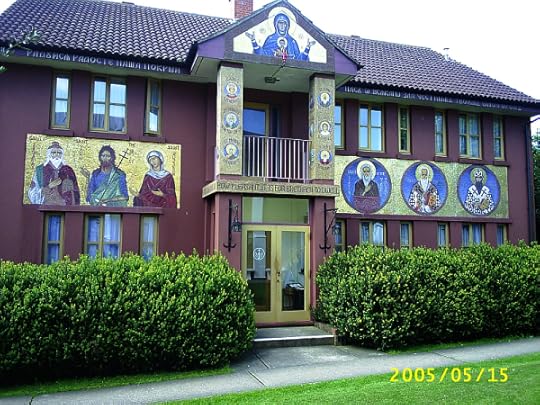
Monastery of St John the Baptist
On one of the buildings of the monastery there was a mosaic of Noah’s Ark with all the animals, and Sister Seraphima pointed out a seagull that had been worked on by a member of our parish of St Nicholas of Japan in Brixton, Johannesburg, Ellie Mullinos, who had stayed at the monastery a few years before (Ellie Mullinos is the oldest member of St Nicholas, and celebrated her 100th birthday a couple of years ago).
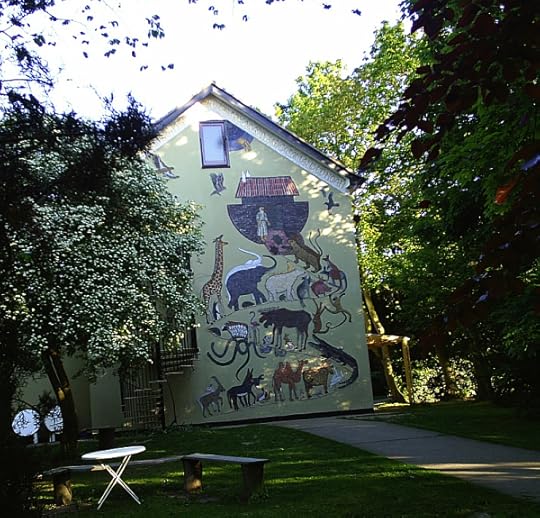
Mosaic at the Monastery of St John the Baptist. The seagull made by Ellie Mullinos is in the top right-hand corner.
We left about 12:00 and drove to Colchester, where we had lunch at a pub, and looked round some of the shops, and then began looking for “Ye Olde Swan” hotel where we were booked to stay, but could not find it in the High Street, so we phoned it, and found that it was in Brightlingsea, and not in Colchester, and was about 9 miles out of town. We drove out there, booked in, and then went back to Colchester and found St Botolph’s Church, where August Decker and Mary Morton had been married, and took some photos of the church and the old priory there, though the church itself had been built only about 20 years before they had been married in it.
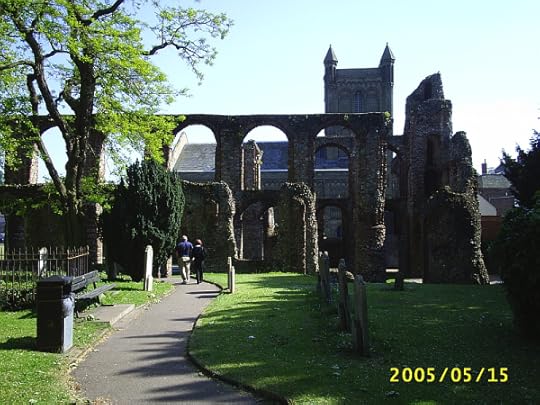
St Botolph’s Church, Colchester, Essex, with the ruins of the old priory in the foregrouind. 15 May 2005
Mary Morton was Val’s great great grandmother, an Essex girl, and was married at the age of 13. Two of her sisters were married in the same church on the same day, and all three of them were married to German soldiers. You can read more of that story here. It seems that Essex girls were going cheap that day, and still are, according to this shop window in Colchester High Street…

We had heard about Essex girls before coming to England, and it seemed that some of the things we had heard were true.
Though actually these three Essex girls had quite a tough life in the Eastern Cape in the 1860s.
We went into the church, where they were preparing for a “united service”, and were setting up an enormous sound system. It only started at 8:00 pm, however, so we thought we would not stay for it.

St Botolph’s Church, Colchester, Essex.
We drove back to Brightlingsea and walked round the harbour, and then back to Ye Olde Swan, but they did not serve supper, so we went to the Raj Indian Restaurant nearby, which served very good breyani.
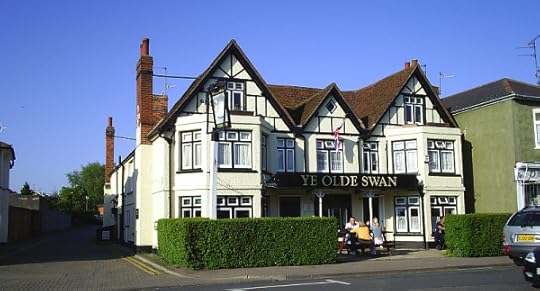
Hotel in Brightlingsea, Essex. 15 May 2005
We went to sleep in our Tudor room, with low doors and creaking floors and original Tudor beams. Like most of the places we have stayed in, except the first, they did not provide a table to write on.
To be continued.
Index to all posts on our UK trip here UK Holiday May 2005


May 13, 2015
UK trip 14 May 2005: cathedral & monastery
Continued from UK Trip 13 May 2005: Stockton to Cambridge | Hayes & Greene family history
We spent the night with Father Michael and Jeanne Harper at Harston, near Cambridge. Over breakfast we talked to Fr Michael about theological education, and he told us about the Institute for Orthodox Studies affiliated to Cambridge University. I mentioned my long-held vision of a cooperative English-speaking distance education institute, which could draw on people from all over the world, and produce lectures on DVD or videotape, and he seemed to think it was a good idea.

Jeanne and Michael Harper, Harston, Cambridgeshire, 15 March 2005
Michael Harper had been an Anglican priest and was Director of the Fountain Trust, a group set up to promote charismatic renewal in the Church of England. When I was an Anglican in Zululand one of the other clergy lent me one of Michael Harper’s books, Let my people grow. In the book he advocated the abolition of the diaconate in the church, and I took issue with him on that and wrote to him about it. At the time (December 1977) I had just been appointed Director of Training for Ministries in the Anglican Diocese of Zululand, and had inherited six newly-ordained self-supporting deacons who had been trained by my predecessor. I soon discovered that none of these deacons had any idea of what a deacon was supposed to do, and neither did the priests in the parishes where they were serving. In fact the Anglican Church generally had no idea about what do do with deacons, and Michael Harper was simply reflectingt this when he wrote in his book that he thought the diaconate should be abolished. On the contrary, I thought the diaconate needed to be restored, and this led to some correspondence back and forth.

Deacon Stephen Hayes and Fr Michael Harper 14 May 2005
A few months later we had a burglary at our house, and Michael Harper sent us a cheque for £25, which seemed remarkably generous. I met him face to face in 1983, when he came to speak at a Spring School run by the Anglican Diocese of Pretoria, and and we continued to correspond after we had both joined the Orthodox Church. Jeanne Harper had a music pupil after breakfast, and so we left, as they were very busy. We went to Ely, and had a look at the cathedral there, and changed some money.

Eliy Cathedral, Cambridgeshire. 14 May 2005
We then went to see my cousin Michael Hayes at Manea, a little village out in the fens. The countryside was dead flat round about, and looked like parts of Holland — all that was missing was the windmills, and again there were many fields of yellow rape seed. I did not recall seeing that particular crop when I had been in the UK before but now it seemed to be all over the south of England.

Rape fields in Cambridgeshire, 15 May 2005
Michael Hayes and his wife Karen were living in a house they were doing up, and their two children were Julia aged 3, and Jonathan, aged 10 months. Michael was the first of the relations we had met who spoke with a real Bristol accent, or indeed any local accent accent at all. It seemed strange that we had spent some time in and around Bristol, but had to come to Cambridgeshire to hear a Bristol accent. We had lunch with them — ham and tomato rolls — and then went on our way again, heading south to the monastery of St John the Baptist at Tolleshunt Knights near Tiptree in Essex.
At first the monastery seemed deserted, and we could find no one around the place, but then one of the sisters came out, and showed us where we could get tea, and Brother Basil, a young monk, showed me where my room was. I just had time to put my bags in the room before we went to Vespers, or rather the vigil, in the church, and they got me to read the Six Psalms at the beginning of Matins. Then we went for supper at the refectory, which was a converted chicken shed, and had won an architectural award for the most imaginative conversion of a building to a different use.
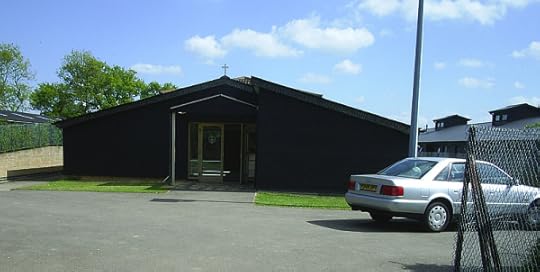
The awardwinning refectory (trapeza) at the Monasstery of St John the Baptist, Tolleshunt Knights, Essex, 14 May 2005
One of the priests who had served at Vespers was sitting next to me, and asked if the great English dish of baked beans was also to be found in South Africa. I think he was French.
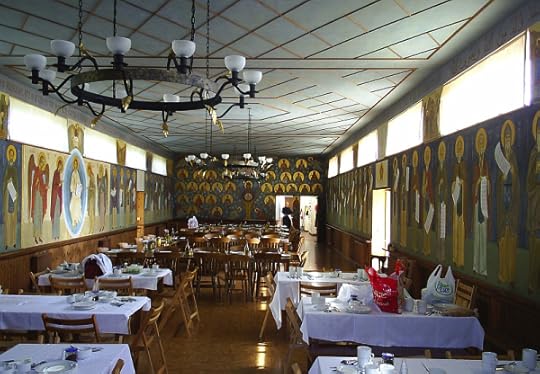
The refectory at the Monastery of St John the Baptist
To be continued
Index to all posts on our UK trip here UK Holiday May 2005


May 12, 2015
UK trip 12 May 2005: Edinburgh to Stockton-on-Tees
Continued from UK trip 11 May 2005: Girvan to Edinburgh | Hayes & Greene family history
We spent the night with Val’s cousins John and Maxine Wincott at Fairmilehead, Edinburgh. John went to work at 7:15 am, and Maxine, who had the day off, took us on a tour to Arthur’s Seat, where there was a view over the town.
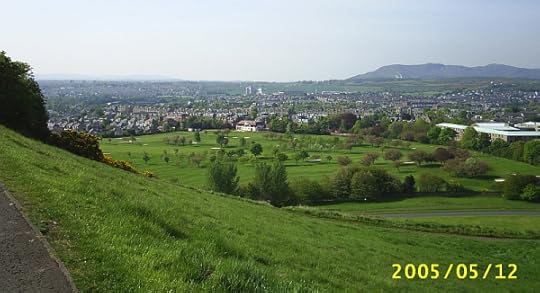
View of Edinburgh from Arthur’s Seat
We drove back through a different part of town, and left Edinburgh about 10:00 am.
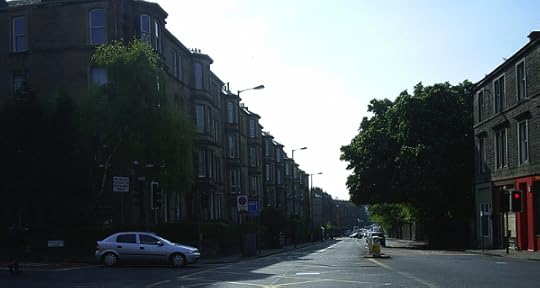
Edinburgh street scene
Stopped at Eyemouth, near the English border, to change money to English money, and bought some more postcards to send to the kids.
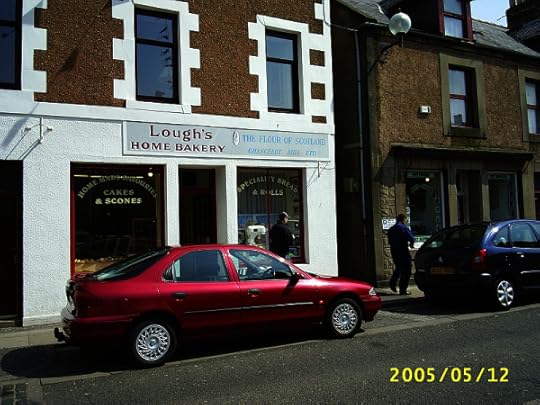
Eyemouth. The sign on the bakery reads “The flour of Scotland”
Our next stop was Holy Island, where we explored the ruins of the abbey at Lindisfarne. It was a remarkably peaceful place, and we were lucky to arrive when the tide was out and it was safe to cross the causeway.
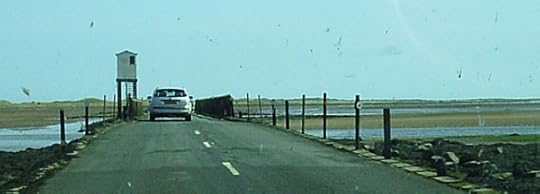
The causeway to Holy Island. The causeway can only be used at low tide, and the poles at the side of the road show where the high tide reaches, to indicate when it is unsafe to cross.
The Holy Island, Lindisfarne, was one of the first mission stations in England. St Aidan came from a monastery at Iona, also an island, on the west coast, and made his base at Lindisfarne because it was strategically close to the royal palace at Yeavering and even closer to the royal fortress at Bamburgh.
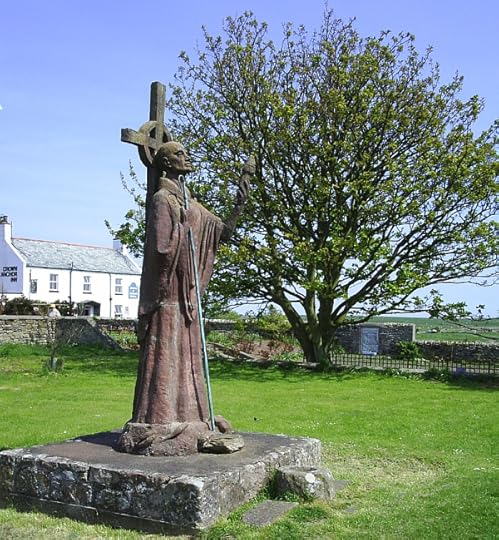
St Aidan, missionary to the English. He established the monastery on Lindisfarne as a base for his evangelistic journeys.
St Aidan then began his task of evangelising the Kingdom of Northumbia. He travelled everywhere on foot, so as to meet people on equal terms. He set up churches in royal townships and established monasteries for men and women.
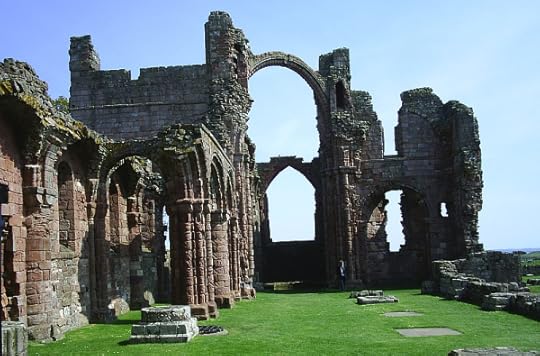
Ruins of the monastery at Lindisfarne, an important missionary centre in England. It was forcibly closed on the orders of King Henry VIII in the 1530s.
Soon the church in Northumbria was strong enough to branch out into evangelising the neighbouring English kingdoms. As a missiologist I had studied this as part of Christian mission history, but it was interesting to see the place with my own eyes. We wandered round the ruins of the abbey, and looked in the museum, and got some ice creams to lick as we walked back to the car park a little way out of the village. The car park was quite enormous, and was only about a quarter full.
Continuing south we passed the outskirts of Morpeth, where Ted and Margaret Worsley lived, or had lived. Margaret was sister to Norah Pearson’s husband John, and aunt to Maxine Wincott. When Norah had first begun writing to us, about 30 years ago, she had said that their daughter Caroline was a silver waitress at a hotel in Morpeth. I’d pictured something dark and romantic and mountainous and Wuthering Heightsish, with brown stone back-to-back houses and wild moors all around, but instead it was remarkably flat and unremarkably ordinary. We did not stop or try to look for the Worsleys, as we did not have an address for them. Their daughter Caroline, who must now be well into her 40s and single, was somewhere in Scotland.
We went on to Durham, where we parked in a new parking garage near the bypass bridge, and went first to Barclays Bank where I enquired about my account, but found that it had been closed, though they hadn’t seen fit to tell me that.
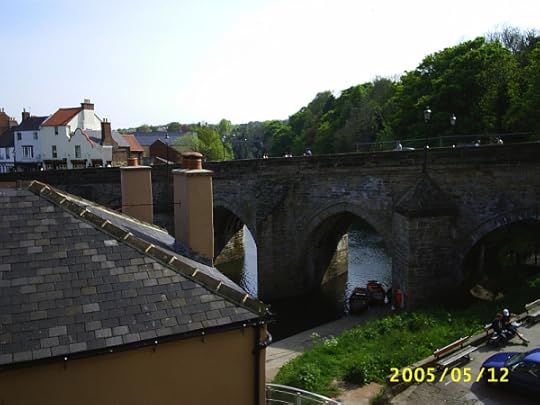
Durham: Elvet Bridge from a new parking garage.
We went up to the cathedral, and venerated the relics of the Venerable Bede in the Galilee Chapel, and went to the museum of St Cuthbert’s treasures. It did not seem appropriate to venerate St Cuthbert’s relics, as they were in far too much of an exhibition, and not as I remembered them, when they had been on a more human scale rather than in special cabinets. I remembered seeing his pectoral cross and an old coffin in which they’d found it, but now the cross was stuck in the middle of a blob of transparent plastic, with spotlights on it. I wondered what would happen if the plastic got discoloured or something — it would probably damage it horribly if they had to chip it out.
We went out into College Green, where the chapter houses were, and that seemed unchanged from nearly 40 years ago.
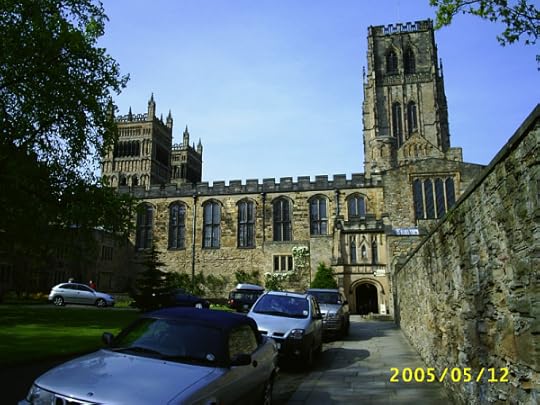
Durham Cathedral from the chapter close on College Green
We went through the gates into the Bailey, and walked down to St Chad’s College, where I had been a student 1966-68. We went to pay our respects to the principal, Fr Joseph Cassidy, who took us on a tour of the college. They were still using the old wooden chapel, where a new altar of light wood had been installed, in place of the old wedding-cake one. That was a bit surprising, as 40 years before there had been plans to take over the nearby Church of St Mary-le-Bow, and to use that as the college chapel. They had built new places in the courtyards, and the college now had women in it, but much was little changed. We went up to see my old room on Cape Horne, but probably no one called it that any more, or if they did, no one would know why it was called that. It had been named after another South African student, Bryan Horne, who had preceded me at the college, so I had never met him. His room had been in that part of the college. Bow Cottage, where I had lived in my first year at St Chad’s, was still at the end of Bow Lane, though looking somewhat posher than when I had lived in it, and apparently no longer belonged to St Chad’s.
We walked across Kingsgate Bridge, taking photos up and down the river. Dunelm House, the people’s gin palace, looked much the same, except that the concrete had gained some dark streaks.
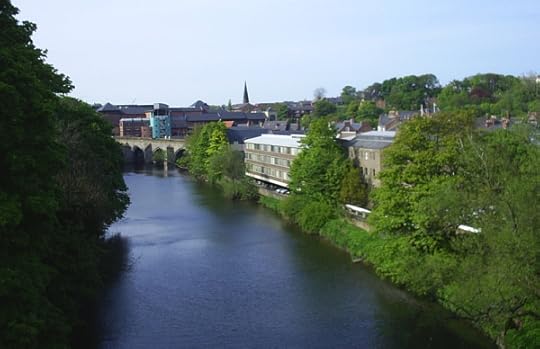
Durham: the River Wear from Kingsgate pedestrian bridge, looking upstream towards Elvet Bridge
We walked back down New Elvet, and over Elvet Bridge, now pedestrianised since the by-pass had been built.When I had been a student, it was a busy main road, taking not merely town traffic, but much of the north-south passing traffic as well. The traffic was controlled from a police box in the Market Square, allowing it to pass from each of the bridges on to the peninsula one at a time.
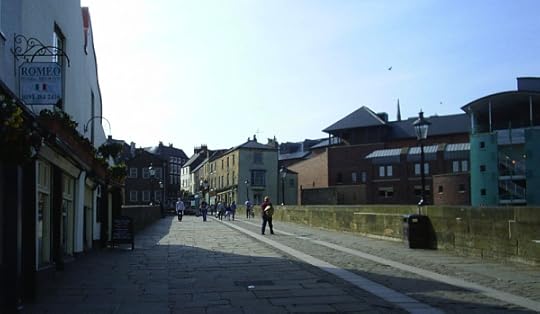
The now pedestrianised Elvet bridge, looking towards the town centre of Durham. On the right is the new parking garage, which had not been there when I was a student.
There were still boats for hire under the bridge, but it seemed that the punts had gone. We bought a couple of sandwiches to eat on our way, down to Stockton-on-Tees to see Chris and Nina Gwilliam, arriving there about 5:30. Chris had been a fellow student with me at St Chad’s College in 1966-67, and Nina had been a student at one of the other Durham colleges.
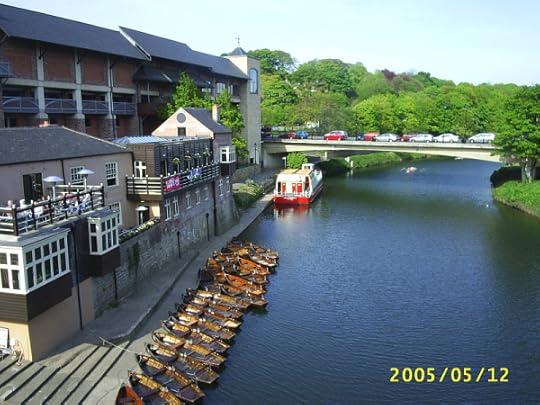
River Wear looking upstream from Elvet Bridge, with the by-pass bridge and the new parking garages on the left
We had a magnificent supper of chicken Madras cooked by Chris, and chatted until 11:30, mainly about the new house they had bought in France, and were planning to move to. They said there was too much crime in Britain. They said their present house was one they did not feel at home in, and I was rather surprised at that — I thought it was a rather nice one. On my first visit to Britain nearly 40 years ago, I had been horrified by the terrace houses, now I did not mind them at all, and thought I would be quite happy to live in their house.
Both Chris and Nina had become Quakers, and Nina had done it first. I would not have recognised Chris if I had passed him in the street, as he had changed a great deal. He was still in his business of painting model railway carriages, which seemed to bring him in some income, but was planning to retire from that when he moved to France.
Continued at UK Trip 13 May 2005: Stockton to Cambridge | Hayes & Greene family history
Index to all posts on our UK trip here UK Holiday May 2005


May 10, 2015
A birthday, a requiem, and a new puppy
It’s been a busy day. It was our son Jethro’s birthday.
We got a phone call in the morning saying that there would be no one at the children’s home in Atteridgeville, where we were planning to go for a service. It was too late to go anywhere else, except perhaps St Sergius in Midrand, where we thought the Divine Liturgy started a but later, so we went along to it. It’s been a long time since we were there, and i9n fact it was the first time we had been during the time of the present priest, Fr Daniel.
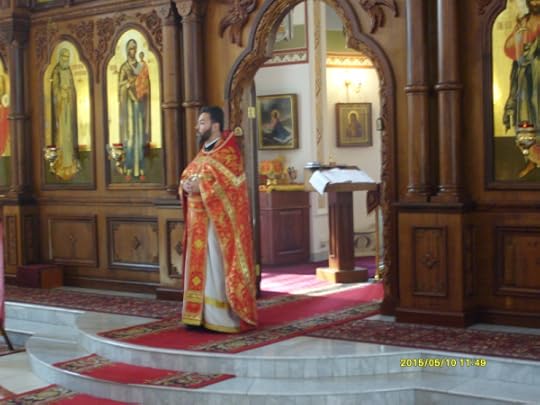
St Sergius Orthodox Church, Midrand, Gauteng
They also had a special Requiem afterwards it was the 70th anniversary of the end of the Great Patriotic War (World War II in Europe). It was held at a chapel outside the main church, dedicated to |St Vladimir. We had not seen it before, and we found out that it was erected in memory of the Russians who had been killed in the Anglo-Boer War (1899-1902).
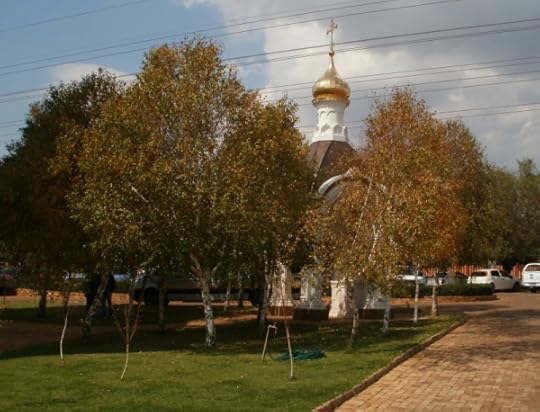
Chapel dedicated to St Vladimir, in memory of the Russians killed in the Anglo-Boer War
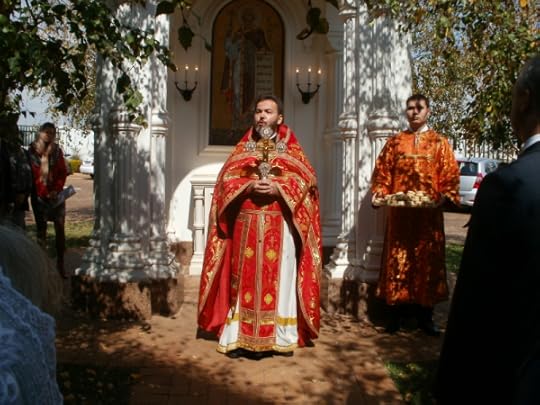
Memorial service for the war dead.
When we got home we went out for lunch to celebrate Jethro’s birthday, and then we went to get a new puppy. One of our dogs, Squiffylugs, has cancer, and doesn’t have logn to live. Our other dog, Samwaisw, will need some canine company when she is gone, and we thought, since she had never had any puppies of her own, and adopted puppy might giver her a sort of surrogate motherhood.
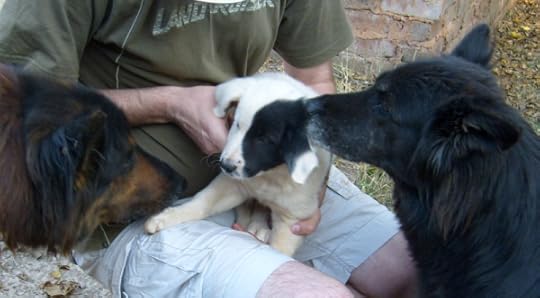
Our new puppy, Pimen, being introduced to his new family, Samwise on the left, Squiffylugs on the right.
The new puppy is a Border Collie, and we are thinking of calling him Pimen, which means shepherd or pastor.
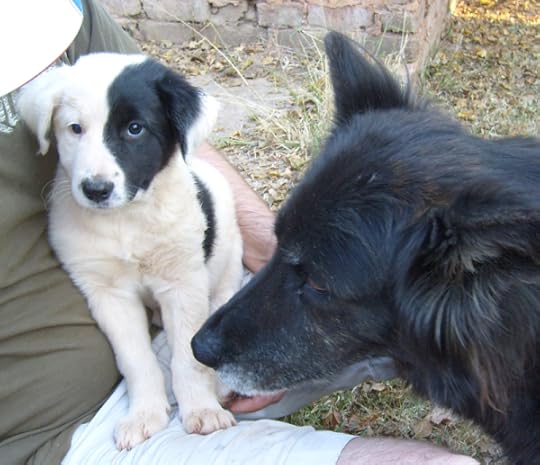
Pimen and Squiffylugs
Squiffylugs immediately got all maternal, and inspected him for fleas, nibbling him all over (and slobbering over him at the same time). Samwise brought his ball, perhaps worried that with the new arrival no one would be interested in throwing his ball for him.
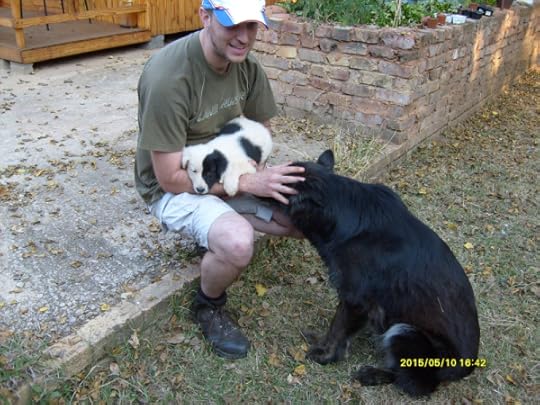
Jethro’s birthday photo, with the new addition to the family.
If this blog post seems a little incoherent, that’s because it’s difficult to write with a puppy demanding attention.


May 8, 2015
UK trip 8 May 2005: Davies family at Gobowen
Continued from Wales and Ellwood cousins | Hayes & Greene family history.
We were up at 6:00, and left the “Grill and Tea Room” at 7:50, driving up the road past Llanberis, through the Snowdonia National Park to Porthmadog.

Mount Snowdon, in the Snowdonia National Park. 8 May 2005.
The tea room had offered only a rudimentary breakfast, and we stopped at a stall on the side of the road for sausage and bacon butties, and the woman who ran it said she had been in South Africa for three years. She had only been running the stall a few months. It was called “Snax”, and seemed well-positioned for custom, just far enough from any town to catch people being hungry on a journey. A bloke came after us and asked for “Best and mushrooms”, and none of us understood what he meant, and he said it was “B.E.S.T: Bacon, Egg, Sausage and Tomato”, and said it was quite a common term where he came from.

Snack staal at the roadside
We reached Oswestry about 11:30, and drove on to Gobowen to see John and Shirley Davies, but they were not at home, so we went back to Oswestry and got the car washed, and filled up with petrol. The flowers that had fallen on the car the first night we had it, at Beckington, did not come off in the wash though. The Davies were still not back when we drove past their house, so we went on to Whittington and had lunch at the pub there, Ye Old Boote Inn, and there was a bike show at the castle over the road.
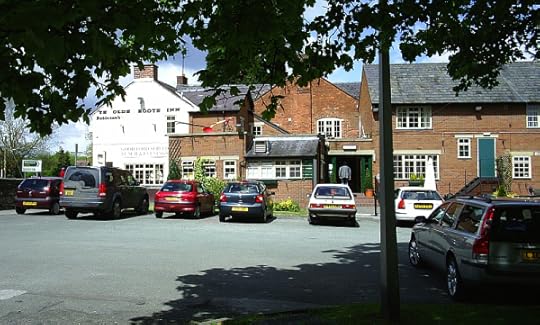
Ye Old Boote Inn at Whittington
We’d left a note for the Davies, and John phoned while we were having lunch, so after lunch we drove back to their house Nyddfa, in Bypass road. John and Shirley Davies seemed little changed since I had last seen them over 30 years ago, and we chatted to catch up on things that had happened in the intervening time.
John and Shirley Davies had been invited to South Africa by Ambrose Reeves, the Anglican Bishop of Johannesburg, in the�� 1950s. The way Bishop Reeves told it, he had invited them because they were in the parish of Halton Moor, in Leeds, where there had been a revival of parish life, with regular parish meetings, house churches and various other good things. He hoped that they would introduce such things in the Diocese of Johannesburg. John became parish priest at Evander in the area that later became known as Kragveld, because of all the coal-fired power stations there.
He was invited to speak at the Wits University Anglican Society in 1959 and 1960, where I was a student at the time, and read a paper of Christian art that made a deep impression on me. He read another one at a conference of the Anglican Students Federation in 1961, on Religion versus God, which made an even deeper impression. Though I wasn’t at the conference I listened to a tape recording of it several times, and eventually typed it out and distributed as a tract. Seventeen years later I read a book by Fr Alexander Schmemann, For the Life of the World, which had similar notions of the battle between God and religion.
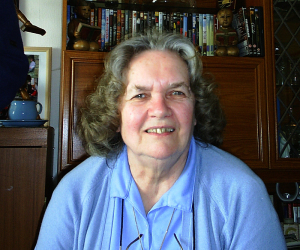
Shirley Davies at Gobowen, 8 May 2005.
John Davies became Anglican chaplain at Wits University in 1963, and he his wife Shirley and their three children, Mary, Mark and Elizabeth came to live in Johannesburg, where I was living at the time, and became good friends, and taught me a great deal.
One thing that Shirley used to say in 1964/65 has stuck in my mind, and I sometimes mention it to other people. Back then the dominating feature of South African life was apartheid, and when students came to their house in Parktown that seemed to be the topic of almost every conversation. And Shirley would say, “When South Africa has solved the problem of the blacks and the whites, you’ll come face to face with the real problem for the first time: the problem of the Haves and the Have nots.”
Fifty years later I have cause to remember her words, as during the last 21 years when we should have been tackling the problem of the Haves and the Have-nots, very little has been done.
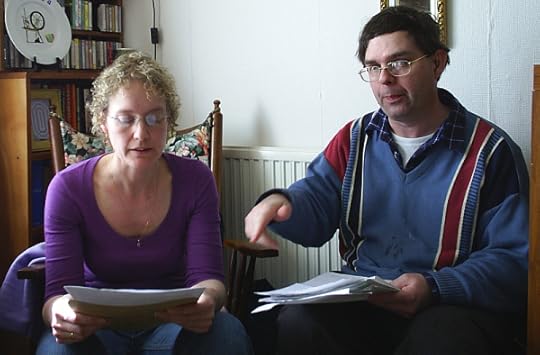
Mary & Mark Davies. 8 May 2005
Mark was still deaf, and though he could lip read, needed things explained to him. Shirley made more lunch of bacon butties, which was our second lunch, so we were well fed. In the afternoon Elizabeth arrived, with her children Nicholas, Michael and Bethan. It was Michael’s 13th birthday recently, and we had a celebration of that too.
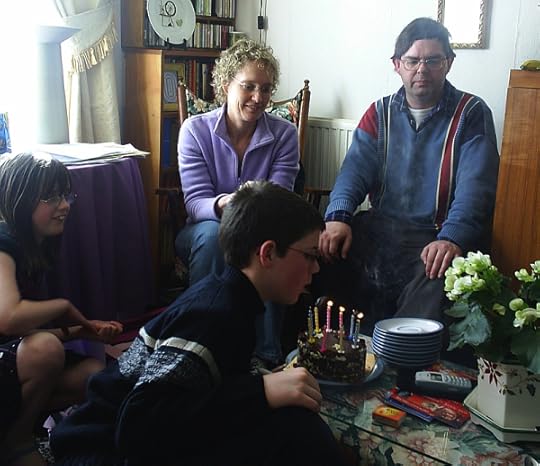
Mary & Mark Davies with Bethan and Mike Price, Gowbowen, 8 May 2004
Bethan said she was doing a school project on Botswana, and we tried to teach her the only Tswana song we knew:
Mangwane Mpulele, ke ne la ke pula
Ga de le pedi, ga de le tharo
Dinyala mosadi
I wasn’t even sure if my transcription of it was correct, since I’d learnt it at a campfire in the veld near Gobabis in Namibia from an Austrian tourist who had recently crossed over from Botswana where he had learnt it. According to him the translation he had been given was “Mother of my girlfriend, I’m standing in the rain. Let me in and I’ll marry your daughter, and if you have two or three daughters, I’ll marry them all.”

Mike & Bethan Price, Gobowen. 8 May 2005
Mary arrived a little later, unaccompanied by her children, who were busy with exams, or her partner, who was suffering from sciatica. We looked at some old photos Mary had brought, many of which were ones I had sent her when she was a child, and which she had kept. We had brought a few of our pictures taken when I had known them thirty years before, and Mark was particularly pleased to see one of his old friend Justin Baker, whom he had not seen for so long.

Recalling the past: Justin Baker, Liz & Mark Davies, with Steve Hayes (photo taken by Mary Davies). Parktown, Johannesburg, July 1968.
We went outside to take a photo of the whole family.

Davies family at Gobowen, 8 May 2005. Nicholas Price, John & Mary Davies, Liz, Bethan & Mike Price, Shirley & Mark Davies.
When the children and grandchildren had all left, we sat talking, mainly about theological education, and went to bed about 10:30.
We had a lot to talk about after 30 years.
To be continued.


May 1, 2015
UK trip 2 May 2005: Heathrow to Bath
Continued from UK Trip May 2005 | Hayes & Greene family history
Our plane from South Africa landed early, just after 6:00 am, and Val got a cell-phone kit, and then we went to get the car we had hired,�� a Fiat Punto. We drove down the M3 to just before Winchester; all the trees were spring green, and the birch trees looked particularly beautiful. The ones in South Africa were in their late summer dark green, beginning to turn yellow, and here they were the light and bright spring green.
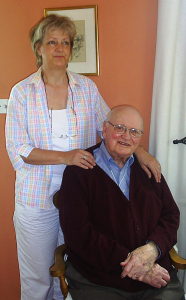
Cathy & Richard Wood, Itchen Abbas, 2 May 2005
We turned off to Itchen Abbas, where we saw Richard and Cathy Wood, and had to catch up with 30 years of news, since we had last seen them. Richard was now 84, and had not been well, and their daughter Rachel was there, with her husband Jean-Bernard d’Arcy and son Antoine, who was about a year old. They normally live in Toulouse in France, but had come to help look after Richard who had been ill.
Richard Wood had been an Anglican priest in Fort Beaufort, in the Diocese of Grahamstown, and when his first wife died he toyed with the idea of becoming a monk. The Anglican bishop of Grahamstown, Bill Burnett, suggested that he work in Namibia for a while, to see how he coped with solitude, so he lived and worked at Keetmanshoop, and when he visited Windhoek stayed with us in our commune, the Community of St Simon the Zealot (whiat would now be called a “new monastic” community). On these visits he met Cathy Roark, who had come from the USA to be a youth worker at St George’s Cathedral. When Cathy left to return to the USA, Richard met her in England, where he was doing a tour of Anglican religious communities to see which might be a good model for Namibia. Cathy accompanied him on one of these visits, and they decided to get married, and Richard wrote back to the bishop in Windhoek, Colin Winter, to say that he had at least found one other person to take life vows.
Later, after Bishop Winter had been deported from Namibia, Richard was elected as suffragan bishop, and eventually he himself was deported.
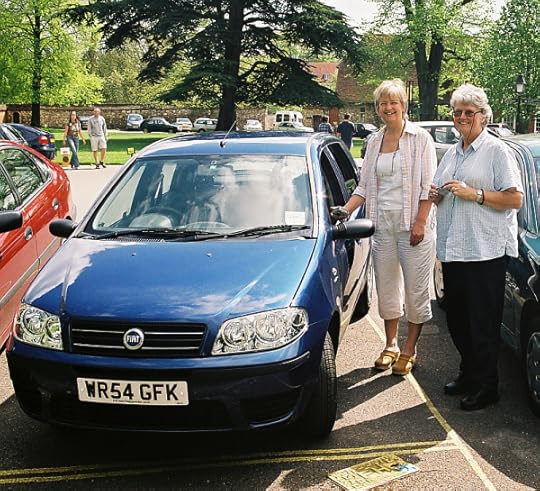
Cathy Wood & Val Hayes, Winchester, 2 May 2005
Cathy took us to see Winchester, and we took some photos of the cathedral and other buildings, including the house where Jane Austen had lived, near the Cathedral. The day had started rainy, but was now turning sunny. Winchester had lots of narrow streets.
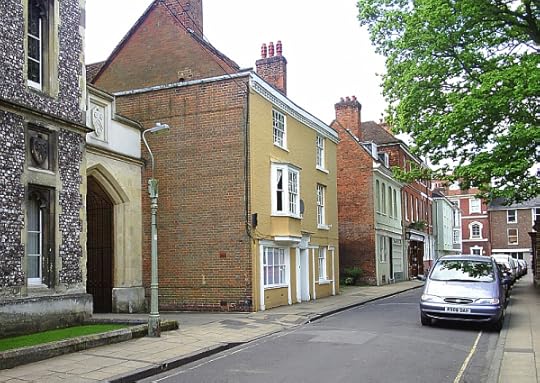
Winchester, 2 May 2005. The house that Jane Austen had lived in.
Then we had lunch at Richard’s favorite pub, sitting outside in the sunshine, and chatted about Namibia and the activities of the Security Police back in the days when it was still ruled by South Africa. We had a look at the river, and Cathy told us that it had originally been a swamp, but King Alfred had channelled it in order to build Winchester. Now, however,�� environmentalists wanted it to return to swamp.
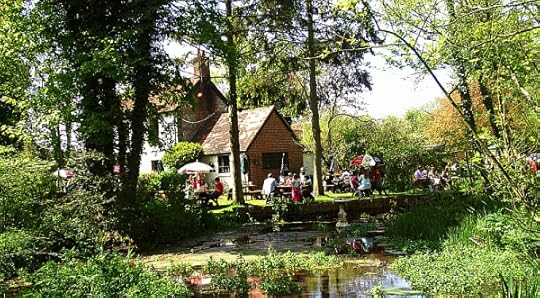
The pub where we had lunch 2 May 2005
We talked about friends from Namibia. Cathy said that John Witherow, who had come from England as a volunteer to help with education,�� was now the editor of the Sunday Times, which had turned into a rabid right-wing rag. That surprised me — not that it was a rabid right-wing rag, but that John Witherow was the editor of such a paper.
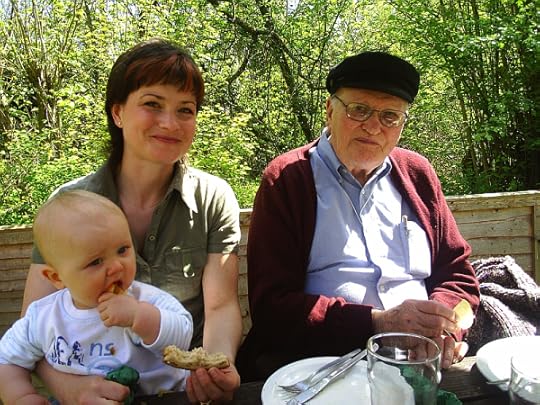
Antoine & Rachel d’Arcy and Richard Wood. 2 May 2005
When I had been in the UK in the 1960s, the British Sunday Times had been a good newspaper, one of what had been called the “quality Sundays”. In 2000 I picked up a discarded copy at Rinas airport in Albania, and was quite shocked to see how it had deteriorated — all objectivity in reporting had gone, and had become nothing more than a vehicle for propaganda.
We left the Woods about 2:30 pm, and drove through some picturesque villages along the way, Stockbridge, and Nether, Middle and Upper Wallop,�� then turned off to look at Stonehenge. Val had seen it before, but I hadn’t. It looked smaller than I had expected, and we took some photos from the hill above.
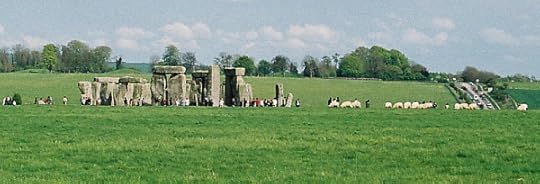
Stonehenge, 2 May 2005
We drove on to Beckington, where we arrived at 4:30 pm, and booked in to Pickford House, a bed and breakfast place run by Angela and Ken Pritchard.
After a nap we went into Bath, and drove around looking at the Georgian and Regency houses, as Val wanted to see some of the places mentioned in Georgette Heyer’s novels.
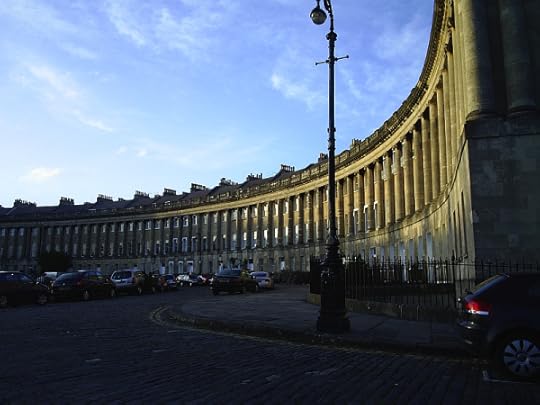
Royal Crescent, Bath. 2 May 2005
We looked at the Royal Crescent, and then had supper at a Chinese restaurant, which was quite expensive, but very good indeed.
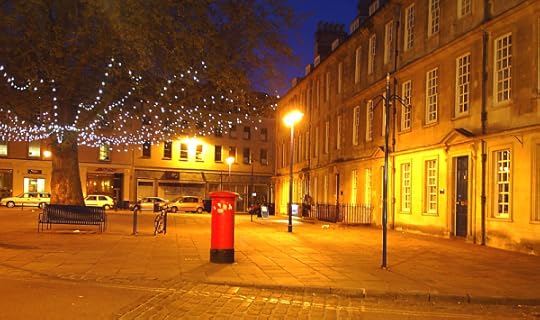
Bath, Somerset, England. 2 May 2005
To be continued…



